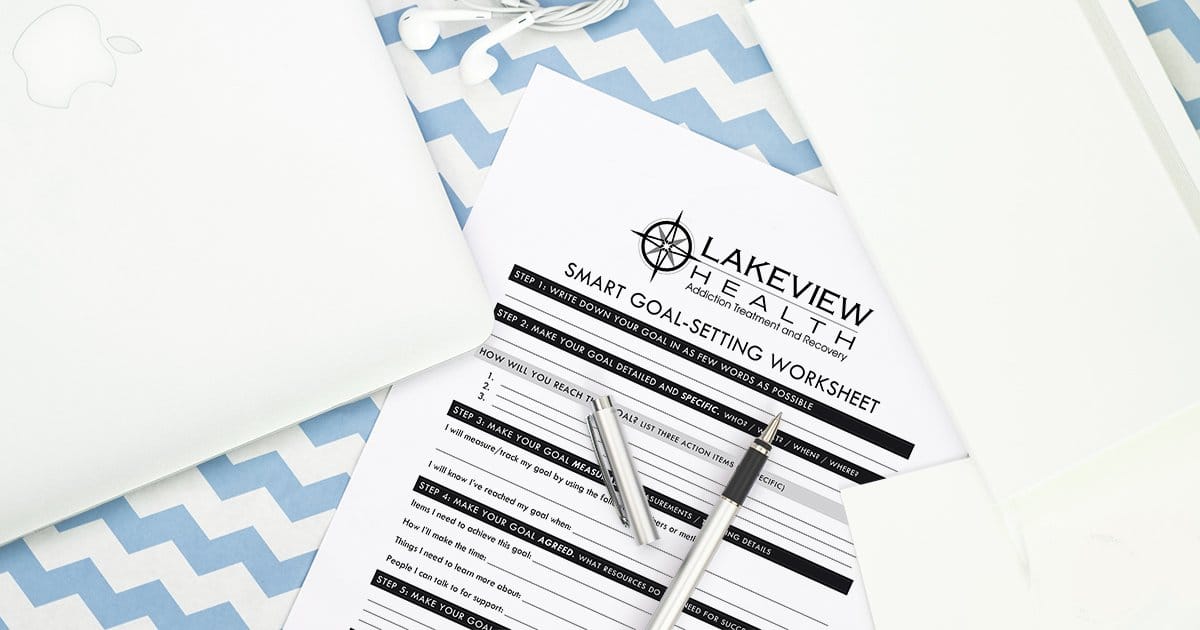

By: Lakeview Health
One of the most important instruments in the recovery toolbox is goal setting. “It’s something I work on with patients a lot,” says Dino Liverano, former clinical manager of the men’s rehab treatment program at Lakeview Health. “Goal setting is important in recovery, and it’s important in life.” It is difficult to realize your goals if it is unclear what they are. “You won’t be able to measure how much progress you have made toward any goal if you cannot identify it. So, one of the things I work on with patients is questions like ‘What specifically are you trying to achieve? What is it you are working for?’”
The three most common goals mentioned by Lakeview Health patients are:
- Sobriety: “I want to get sober”
- Relationships: “I want to repair family and romantic relationships”
- Stability: “I want to have some stability in my life”
The trick of goal setting in addiction treatment is to break down overarching objectives like “getting sober” into smaller steps that are less overwhelming for patients. Similar to employee performance management and personal-development objectives, addiction recovery goals should use SMART criteria: they should be Specific, Measurable, Agreed, Realistic, and Time-based. If goals are too ambitious, the fear of failure can all too quickly rear its ugly head and cause problems. If there is no time limit, patients won’t know when they have achieved them. “We have to turn those large, lofty goals into achievable, more modest objectives,” explains Liverano.
Step by Step
“Goals can be very small and specific or large and non-specific, and if the goals are larger, they should come with more specific, smaller steps,” says Liverano. “If you keep breaking them down into smaller and smaller steps, you will eventually reach a point where the patient says, ‘Okay, I can do that.’ and we can take it from there.” If a patient’s goal is to stay sober, she would then explore with her therapist what she can do to achieve that primary goal. They would then work on a list of steps that gets the patient closer to that goal. “It could be finding an AA meeting or going to treatment—just being at Lakeview is a checkmark already—or connecting with a sponsor.
An example of goal setting for a patient looking to enter treatment could be:
- Accepting your feelings (distressed, overwhelmed, unhappy, excited, relieved) and still taking the actions necessary to move forward.
- Packing the things that make you feel comfortable for your stay.
- If you need support or encouragement as you prepare, call someone such as our admissions or intake specialists.
- Try not to become frustrated if the process feels challenging or slower than you expected. Recovery is a journey, it’s ok to make mistakes in it.
It’s about recognizing the smaller steps that are realistically achievable within a defined period of time and then making progress toward those smaller objectives,” says Liverano. “Another example is apologizing to your mother for something you have done in the past. It’s very specific. Your goal is to identify what you want to say to her and then call her. It’s pretty simple when you lay it out like that.”
Goal Setting Will Make You Heal Faster
The power of goal setting resides in stringing these little steps together until the combined effect shows progress toward the bigger goal. And simply committing to those smaller steps can have a strong healing effect. In his 2014 book The Power of Habit, author Charles Duhigg describes a Scottish study that examined the power of goal setting for patients recovering from knee or hip surgery. Mobilization and exercise are very important for these patients, but the pain can be so extreme that many skip rehab sessions and refuse to perambulate. The study looked deliberately at “the types of people most likely to fail” and made them set weekly goals. Participants had to write down exactly what they were going to do. The patients in the control group did not have to set any goals. “It seems absurd to think that giving people a few pieces of blank paper might make a difference in how they recover from surgery,” writes Duhigg. “But when the researcher visited the patients three months later, she found a striking difference between the two groups. The patients who had written plans in their booklets had started walking almost twice as fast as the ones who had not. They had started getting in and out of their chairs, unassisted, almost three times as fast.” Clearly, the act of writing down small achievable goals had a tremendous effect on the recovery of these patients. Duhigg suggests the recovering patients developed a healthy new habit. They challenged themselves with a difficult but achievable task that entailed a reward—feeling good about their achievement.
Not Only For Rehab
Recovery from addiction is a continuous process. It is a difficult, daily battle that is by no means over when patients leave the residential treatment program. Goal setting can help keep people on track when presented with triggers to use substances and emotional crises. “The most important thing about setting goals is not achieving them all the time but about making progress. Everybody has goals they haven’t achieved yet. I always tell patients, ‘It’s okay that you haven’t reached your goal yet. But you’re making progress toward it, and that’s what matters.’ Not having reached your goal yet should not be seen as a failure. Saying ‘I haven’t done it yet’ instead of ‘I can’t do it’ can make a big difference,” says Liverano.
Addiction Treatment at Lakeview Health
If you or a loved one is struggling with a substance use disorder, contact Lakeview Health today at [Direct]. Our team is ready to help with the admissions process and begin addiction treatment.





